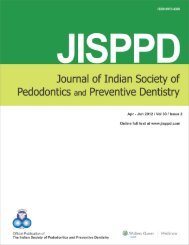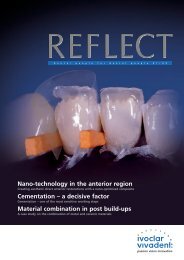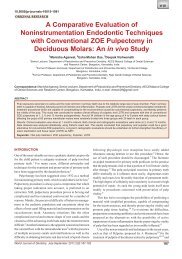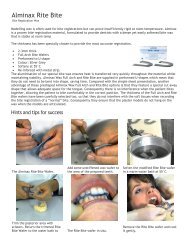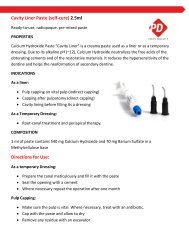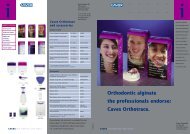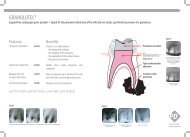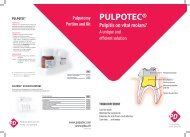Clinical Evaluations
Clinical Evaluations - Universal Dental - universaldental.com.pk
Clinical Evaluations - Universal Dental - universaldental.com.pk
- No tags were found...
You also want an ePaper? Increase the reach of your titles
YUMPU automatically turns print PDFs into web optimized ePapers that Google loves.
temporary cement ‘PD’ in paste. In order to provide good adjacency of the paste to<br />
canal sides and mouth the wad of cotton wool was placed between the upper and lower<br />
molars. The patient was asked to bite it slightly at first and then stronger. The<br />
temporary inlay and preparation were removed during the second visit after 8-10 days,<br />
the fresh portion of ‘Pulpotec’ of denser consistence was deposited into the tooth cavity<br />
and the final sealing was provided. X-ray trials were run before and 6 months after the<br />
treatment to observe dynamics of the process of treatment.<br />
Thorough stanching before depositing of the preparation to avoid blood clot that may<br />
prevent from access of the preparation to the stump of the pulp and tend to<br />
complications upon evidence of infection was the matter of the special attention.<br />
Easiness and simplicity of use of ‘Pulpotec’ were ascertained during the medical trials.<br />
The paste hardens quickly after mixing of ingredients that preventing isolation of<br />
volatile fractions, providing optimal conditions for depositing of cavity liner and seal<br />
and decreasing the time for treatment radically. Preparation does not adhere to tools<br />
and does not strive after them, has good adhesion ability relatively tooth cavity sides. It<br />
is important to mention that uniform paste is produced after mixing of ingredients of the<br />
preparation having no pungent, foul smell and causing no negative reaction of the<br />
patient.<br />
<strong>Clinical</strong> trials provided have shown absence of pains at all patients without exception<br />
after use of ‘Pulpotec’. Even if the pain syndrome was found evident at diagnostics of<br />
odontitis it was completely arrested after depositing of the first portion of the<br />
preparation. No complaints were lodged by patients either in the intervals between visits<br />
to clinic or during the dynamic observation (from 4 to 6 months). No swelling of gum in<br />
the area of the treated tooth was detected during the given period, no evidence of a<br />
fistula and no mobility of a tooth. No signs of destruction of osseous tissue in periapical<br />
tissues were found at control X-ray observation of 14 teeth 6 months after the treatment.<br />
Let us use as example the case of treatment of odontitis (child aged 5) when the evidence<br />
of anti-inflammatory and analgesic action of ‘Pulpotec’ was complete. The patient<br />
Botchkareva T. (born 1998, file #88070) applied to the clinic with complaints for sharp<br />
pains in the area of the lower jam, left side, evidence of swell and pains at swallowing.<br />
Upon examination acute form of hyperemia and edema at diminishing fold in the area of<br />
the 74th tooth were found, acute morbidity of edema at diminishing fold, submaxillary<br />
lymphadenopathy and pains upon palpation. Acute odontitis of the 74th tooth with signs<br />
of periodontitis was diagnosed. Tooth cavity was opened under anesthesia, coronal pulp<br />
ablated, hemostasis with use of ‘Catalugel’ provided and liquid portion of ‘Pulpotec’<br />
was deposited over the stump of pulp and the tooth was temporary sealed. Sufficient<br />
decrease of edema and pains upon palpation of lymph nodes were observed during the<br />
examination next day, no pains were reported. After removal of the temporary seal a<br />
new portion of ‘Pulpotec’ was deposited into the tooth cavity and the tooth was<br />
permanently sealed. In this case we have deviated from the traditional scheme of<br />
treatment when the evidence of inflammation in peridental membrane serves contraindication<br />
for temporary sealing of teeth. According to the actual standard we should<br />
have made pulp amputation, leave a tampon with anti-inflammatory preparation in the<br />
tooth cavity and proceed with treatment by de-vitalization of pulp method after stopping<br />
of inflammation. Traditional treatment shall take 3-4 visits with pain symptoms kept<br />
during several days.



